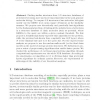1491 search results - page 47 / 299 » Training Linear Discriminant Analysis in Linear Time |
128
click to vote
CVPR
2012
IEEE
13 years 2 months ago
2012
IEEE
Constructing a good graph to represent data structures is critical for many important machine learning tasks such as clustering and classification. This paper proposes a novel no...
RECOMB
2009
Springer
16 years 14 days ago
2009
Springer
Finding similar structures from 3-D structure databases of proteins is becoming more and more important issue in the post-genomic molecular biology. To compare 3-D structures of tw...
117
click to vote
LATIN
2010
Springer
15 years 6 months ago
2010
Springer
Topological self-stabilization is an important concept to build robust open distributed systems (such as peer-to-peer systems) where nodes can organize themselves into meaningful n...
107
click to vote
STOC
2003
ACM
16 years 4 days ago
2003
ACM
Many algorithms and data structures employing hashing have been analyzed under the uniform hashing assumption, i.e., the assumption that hash functions behave like truly random fu...
138
click to vote
SDM
2008
SIAM
15 years 1 months ago
2008
SIAM
Optimally designing the location of training input points (active learning) and choosing the best model (model selection) are two important components of supervised learning and h...

